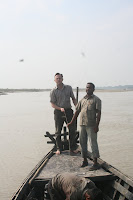 |
| The lads at the vegetable market, Rajshahi |
 |
| Busy street at the market entrance |
Like any such market in Bangladesh it’s photogenic, and there’s real milk tea from that seller on the main street corner to fuel the brief exploration, for though congested the market isn’t big. In some countries people mind it if you snap their picture, but in the market one photo of a group of vegetable sellers can easily become ten, as their friends and friends of friends call out to have group shots taken too. There are the vegetable-patterns of abundance in the baskets, proudly spread on mats, and the old signs and rough stores along the sides of the lane to zoom-in on too.
 |
| Padma sunrise |
Reaching the waking river, all is quiet. Unlike at the vegetable market, Rajshahi can’t act in front of the Padma. The town reclines hammock-style along the river’s northern bank and the Padma has been witness from the beginning. It knows the Rajshahi reality: sleepy, spacious and green.
 |
| Padma riverbank |
Yet even in the early morning some activity has begun. Workers carrying sand and goods have started their ant-pilgrimages, down the wooden plank of a riverboat and onto the sandy shore, time and again. A few joggers ply the paths that are exquisite for wandering, and a group of kids has given to the sky their kite, seemingly preceding the sun itself, which is not yet high enough to escape being caught by the river as a glimmering reflected band.
Along the riverbank, large sprawling trees delight with shade as the sun grows stronger. There are seats, tea-shops and food stalls al fresco to wile away part of a day, to let an afternoon flow as steadily and easily as the river. Adda itself seems to have a more soothing rhythm to it when it’s sculpted with a few random Rajshahi locals at the river’s edge.
 |
| Padma cargo |
There are long-legged Pakistani goats with dangling skin-growths on either side of their throats. They demand a share of whatever you eat; they demand to be stroked like a pet cat and if you stop they nudge for more. Larger domesticated goats than those would be difficult to find.
We look out across the nearest portion of river, in actuality its small northern channel, and beyond the large char opposite, beyond even the main course of the Padma which we cannot see, to a horizon made scraggy with the outline of trees. Where land meets sky is India.
 |
| Chatting with goats |
From the char people come and go in small wooden ferry boats. It took us up and down, one of those boats, and as we watched people on the bank watching us, it gave a sense of journey. Even though the reality was a yawning circle in a few hundred metre water stretch, the chug-chug motor and smoothness of movement made the world seem ever-so-briefly kinder; the daily chores of Dhaka distant indeed.
 |
| Street stall for kalai roti |
The museum is in a well-presented old building, and its displays ranging from intricate temple carvings and ancient pottery to more modern tapestry spill out into the central courtyard. The collection amply demonstrates the region’s age-old cultural achievements, just as Rajshahi itself is a tribute to history, with an impressive range of ornate colonial buildings that together with the wider streets and general cleanliness of the place, evoke the wonder of a bygone age.
 |
| Spoken English |
And to prove Rajshahi can satisfy all, we find the upmarket Aristocrat Café for more substantial meals: air-conditioned, we eat and watch, this time observing the business meetings taking place at some of the tables around us. All those suited gentlemen… well… it’s easy to declare them all mango-nnaires in the midst of mango takeovers and mango deals.
The campus of Rajshahi University is also worth a look. It’s spacious and, endowed with sculptures and tree-lined Paris Road, must be an inspiring environment for study. We are lucky for we have my Bengali nephew from Noakhali – it’s a long story, to guide us, and show us where to enjoy afternoon pastry before he returned to his study.
 |
| Universi-Tea |
For the journey back to Dhaka the train is hard to beat: the mango gardens, banana stands, sugar fields and villages remind that although it sits adjacent to the Indian border, Rajshahi is attached to the abundant heart of warm Bangladesh.
Dhaka is an exciting place to live: like all big cities, it’s fast, varied and offers opportunities smaller cities cannot equal; but like all big cities there are times the constant barrage of crowds, jams, chores and appointments gets a bit much. It’s then a weekend away is required.
 |
| Navigating the Padma |
There are the obvious medicinal choices to cure the rat-race syndrome: Sylhet, Cox’s Bazar and Rangamati; but you could do a lot worse for a weekend getaway than to hop a bus or train to old-charm Rajshahi, even out-of-season when it’s a little cooler there.
How about a trip to Comilla, Chittagong or Dhaka? Or how about a quieter break in the village?
 |
| Scales and Tea and Such |
No comments:
Post a Comment